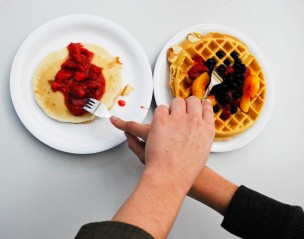
Power to Pancakes
By Emma Davis
Food Editor
Waffles are to pancakes as sandwiches are to panini. Sandwiches are one of the most basic lunch foods, and you can find them anywhere from truck stops to gourmet restaurants; although the quality differs, the fundamental idea is the same. The bread is a layer of fluff with no satisfying crunch, and any cheese is cold and plasticky to the touch. Without condiments or sauces, the dish as a whole is a bland mixture of flavors.
Panini, on the other hand, are warm and inviting, and it takes a special kind of sandwich shop to make them properly. The bread is toasted and its taste enhanced by a bit of oil on the grill, melted cheese oozes lusciously from the sides, and even a simple smattering of ingredients can be transformed into a rich and rewarding meal.
As with panini, pancakes indicate at least some engagement with the kitchen and with cooking as an art. When was the last time you bought a box of frozen pancakes? Unlike waffles, pancakes require a stovetop and a chef’s sense of timing; there’s no machine available to crisp both sides evenly or beep at you when each one is ready. Pancakes also come with a delicious coating of flavor, as they are typically cooked in butter rather than the greasy, artificial spray that coats waffle-makers.
Pancakes also exist in many more forms across cultures. Blintzes, crepes, Swedish pancakes, Ugandan pancakes—just take a look at the list of “regional varieties” on the pancake Wikipedia page, and you’ll see that there are close to 40 different countries of origin. Clearly, people everywhere have been pouring batter onto griddles for centuries, and the explanation is simple: pancakes are delicious and amazingly easy to make.
Then there’s the question of toppings. Fruit, chocolate chips, syrup, whipped cream, butter—a pancake can become the froyo of breakfast foods.
Nonetheless, the real magic lies outside of mere garnishes: with pancakes, these indulgences can be added directly to the batter. Essentially, pancakes offer a miraculous two-in-one, as evidenced by the combination of pumpkin pancakes topped with whipped cream or blueberry pancakes dripping with syrup.
Lastly, there’s the long tradition of pancakes and bonding. When someone sets a stack of steaming pancakes before you, how can you help but feel affection? After all, as author Kathleen Flinn explains, “I don’t have to tell you I love you. I fed you pancakes.”
A Way with Waffles
By Samantha Lau
Contributing Writer
Waffles involve a complex art. To make a waffle, one must carefully pour batter into a waffle iron so that each side will be even. You don’t want one side to become too doughy while another side is crunchy. The end product is a delicious, circular, or rectangular cake. To make a pancake, one simply pours the batter onto the pan, given that its shape does not really matter. Even if you plop a large amount of batter onto the pan, it will even out in the end. The end result of a waffle is a sort of Mona Lisa, and the end result of a pancake is a caveman carving.
The waffle’s sturdy surface allows one to add an abundant amount of toppings and condiments without worrying about the dough disintegrating. When you place the waffle in your mouth, the crispy exterior is comparable to that of a luscious, melty, grilled cheese sandwich. Its soft, doughy interior is like a fresh-baked, pillow-soft dinner roll, giving you the best of both worlds. When you chew pancakes, you receive a singularly gentle and gooey sensation, which soothes your nerves like mashed potatoes but is anticlimactic in its textual stimulation. The waffle never fails to rouse your senses with its range of character and structure.
The architecture and durability of the waffle amazes me. Its three-dimensional form allows it to resist syrup saturation, as its many checkered crevices are receptacles of the liquid. The waffle has a complexity to which no pancake can ever compare. For convenience, most people will choose to make a pancake instead of a waffle, but I don’t mind putting in those extra few minutes.


Leave a Reply